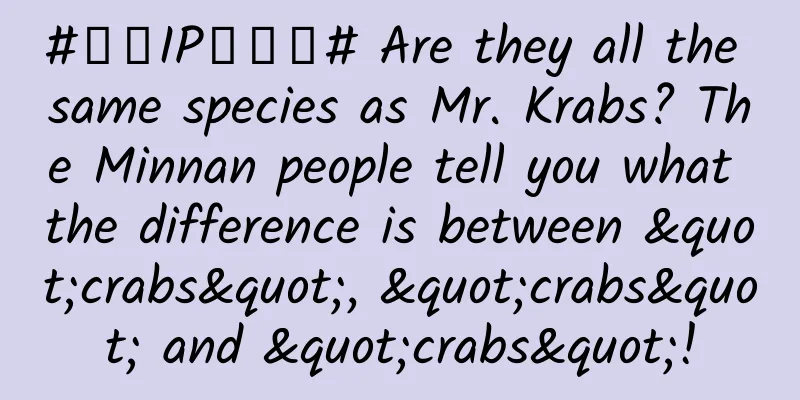#千万IP创科普# Are they all the same species as Mr. Krabs? The Minnan people tell you what the difference is between "crabs", "crabs" and "crabs"!

|
📙Reading tips: The content comes from the dictionary of Shuomin App, and the pronunciation is Quanzhou dialect. “The crab is fresh and plump, sweet and greasy, white like jade and yellow like gold. It is the ultimate in color, fragrance and taste. Nothing can surpass it.” ——Li Yu's "Casual Notes on Leisurely Feelings" When the autumn wind blows, it’s time to eat crabs. Every autumn, if the people in the south of the Yangtze River look forward to the hairy crabs from the lakes, we in southern Fujian prefer the crabs from the sea, which are pronounced as “蟳[ʦim²]” in the Minnan dialect. In Mandarin, "crab" can be used to refer to all kinds of crabs in freshwater, land and seawater. In Minnan dialect, there are "蟳", "蠘" and "蟹" . What are the differences between these three? Although they are all crabs, they have their own characteristics. Crab: Found in streams and creeks, crabs have hair on them, so they are called hairy crabs. Also called crabs, they are very plump in autumn. There are two types of crabs: pointed and round. The pointed ones are male crabs, which are not as yellow and fragrant as the round ones of female crabs. Crab: Red crabs have more fat than meat, while those without fat are vegetable crabs. The large ones are more than a foot long, and they grow in the mud near the sea with one long shell and one long shell. They have hairless claws, unlike crabs. Silkworm: It looks like a crab, but its shell has spots, tastes worse, and its claws are sharper. ——Taiwanese local chronicles from the Qing Dynasty, "Kamalan Hall Chronicles" The most common crab in southern Fujian is the "hairy crab [mŋ² hue⁴]", a type of freshwater crab that is closely related to the hairy crab. Generally speaking, crabs with hairy claws and legs are called "hairy crabs", while those without hair are called "xie". How do you tell the sex of a crab? The carapace under the belly of a crab is called "navel" in Minnan dialect. If the carapace is conical, it is called "pointed navel", which means it is a male crab. Otherwise, it is a female crab. The pointed shell under the belly of a female crab is round, which is called "round navel". "Xie" is just a common name. People in southern Fujian also call it "Xie Zai". Its proper scientific name is "Serrata Scylla", which is a crab of the family Portunidae. The common "red crab", "vegetable crab" and "virgin crab" all belong to this category. The one with more "crab paste [ʦim² ko¹]" is called "red crab". Red crabs appear on the table in two periods of the year, one is from March to July of the lunar calendar, and the other is from September to October of the lunar calendar when the weather is clear and cool. Both are the best time to eat red crabs. In southern Fujian, the ancients actually learned a lot about eating crabs. There is a folk proverb that goes "seven crabs, eight crabs, nine hairy crabs", which records the breeding period of different crabs. As long as you find the right time, you can eat plump crabs. There is also a saying called "Spring crabs and winter hairy crabs", which means that crabs in spring and hairy crabs in winter are the most plump. There is also a saying that when crabs are about to shed their new shells, it is a good time to eat crabs. The crab without roe is called "cai xia", also known as "mo xia". The "mo [phã⁵]" here refers to the loose meat of the crab, while the firm meat is called "tũĩ⁶". "There are mo and tũĩ, and there are su and dang". Just as there are firm and loose crab meat, there are smart and stupid people. This Minnan colloquialism is usually used to refer to the difference between smart and stupid people. "su [siak⁷]" means smart, and also means ripe fruits. "Xie" and "蠘" are both sea crabs. "蠘[ʦʰiʔ⁸]", which we also call "蠘仔", is also a kind of swimming crab, similar to "Xie", but its claws are more slender, sharp, and serrated. "Minzhong Haicuo Shu" (1956) also described it: "蠘 is like a crab but with a large shell... Its claws have serrations, which are sharp and can cut things like scissors." If there are three spots on the back of the shell of "蠘", it is a red star swimming crab, which is called "three-pointed boy" by the people in southern Fujian. Seeing so many names for crabs, have you noticed that you seem to have never heard the Minnan dialect pronunciation of crab? This may be because in the ancient Minnan people’s cognition, the "crabs" and "crabs" in the sea and the "hairy crabs" in freshwater are considered to be different species, so they have their own names. Now everyone should be able to distinguish between "crabs", "shrimps" and "crabs", and can also tell the male and female crabs! The Minnan people have many ways to eat crabs, and the most famous one is undoubtedly "fried crabs and cooked crabs", which is the Minnan people's interpretation of different cooking methods of crabs. The crabs used for frying are often "red crabs", "Shu plate crabs, the top dish on the table." If there is no red crab on the banquet, people always feel that something is missing. Fried crab © Linlin In the customs of southern Fujian, red crabs cooked with sesame oil and a lot of ginger slices can even be used to "replenish the confinement period" for postpartum women, which greatly reverses the inherent cold impression of crabs. "Cooking" means steaming. The meat of swimming crabs is the most fresh and sweet. If it is fried, the taste will be mixed. Cooking can better preserve the original flavor. In the autumn season when the wind blows and the leaves turn yellow, no one should be able to refuse a plump crab, right? I can't refuse it anyway. |
Recommend
[Practical Collection] A comprehensive list of efficient tools necessary for operating Meow and Market Wang
As the saying goes, "If you want to do your ...
91 Ten Articles - New Energy Vehicle Industry Briefing: 1,000 km range will be a reality by the end of next year
1. Fuyao Glass's annual report shows that the...
[Smart Farmers] Spring is here and farming is busy | From south to north, a satellite view shows the colorful land getting ready for farming
"Spring plowing land early" Spring plow...
Show you how to master advanced CP operation routines!
In 2015, I have been troubled by APP promotion an...
Building a brand’s own broadcast account matrix!
On May 25, Douyin’s 618 Good Products Festival en...
Weibo traffic | What is Weibo real-time account? What is it used for and how to raise it?
Why did you think of sharing this today? Because ...
How can paid communities quickly monetize?
If you pay attention to the circles around you, y...
Found in the deep sea, but originating from space, this is the rare element plutonium
By detecting plutonium-244, the heavy metal struc...
Apple releases medical research platform RearchKit, open source!
[[128956]] On March 10, Apple announced the relea...
In-depth analysis of KOL operations from 0 to 1
What I talk about most with friends recently is K...
How much does Baidu paid ranking cost per month?
It depends on where you open Baidu, such as paid ...
Android N internal code name - New York Cheesecake
With the debut of the latest developer preview, t...
Advertising operations in three major industries: real estate, home decoration and home furnishing, and wedding photography!
As spring comes and flowers bloom, marketing in v...
SaaS Advertising Tips
Marketing genius John Wanamaker has a famous sayi...









